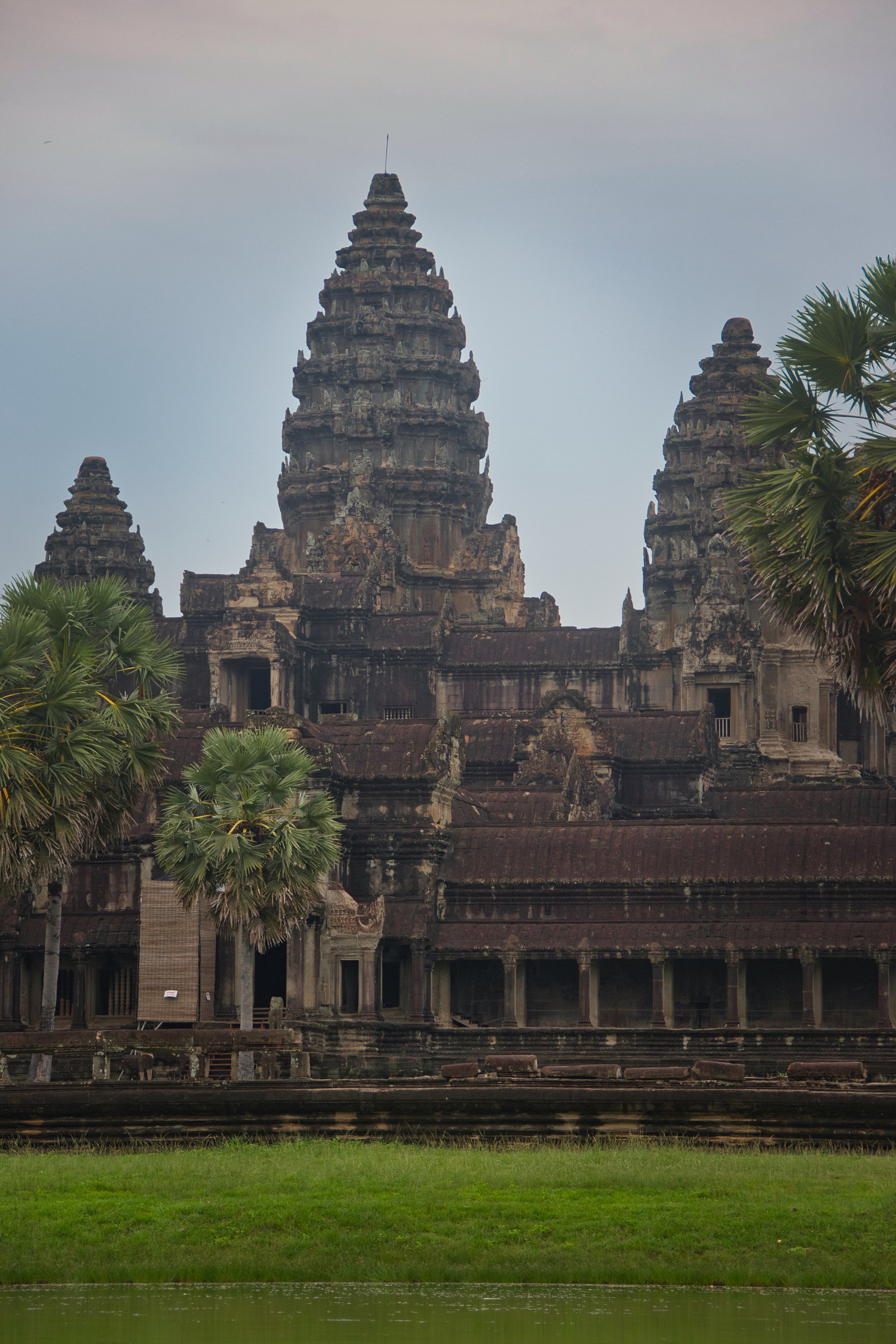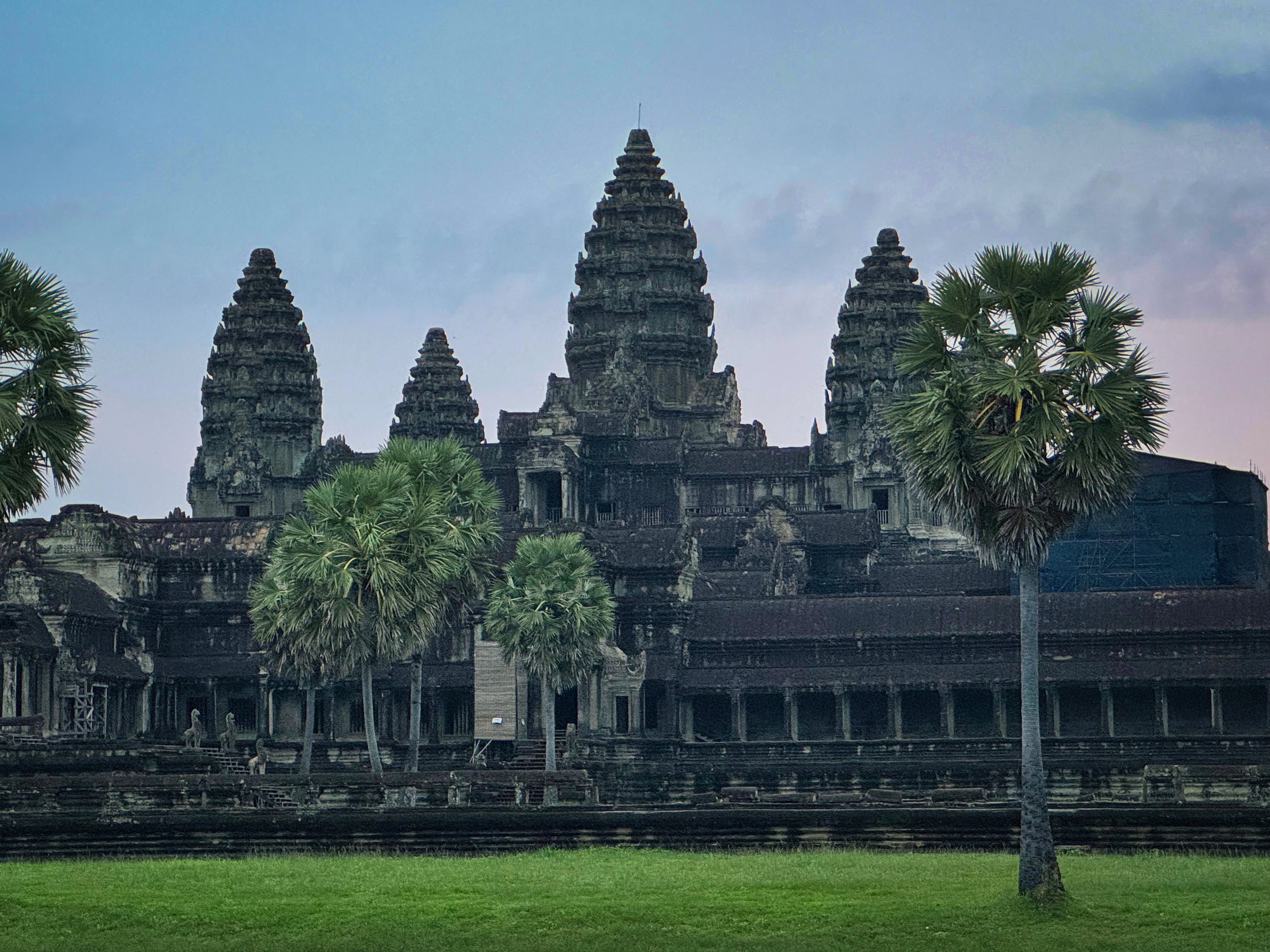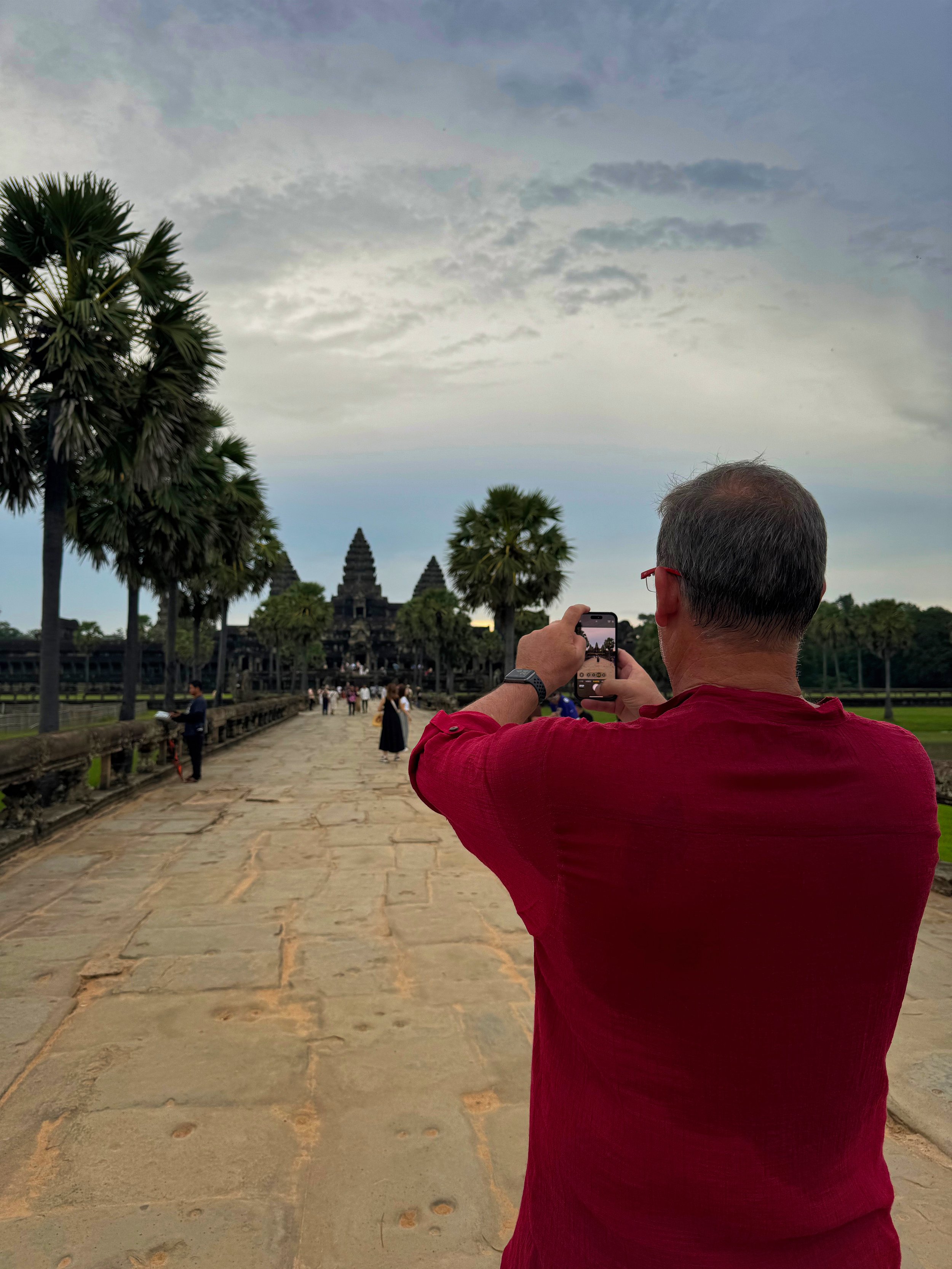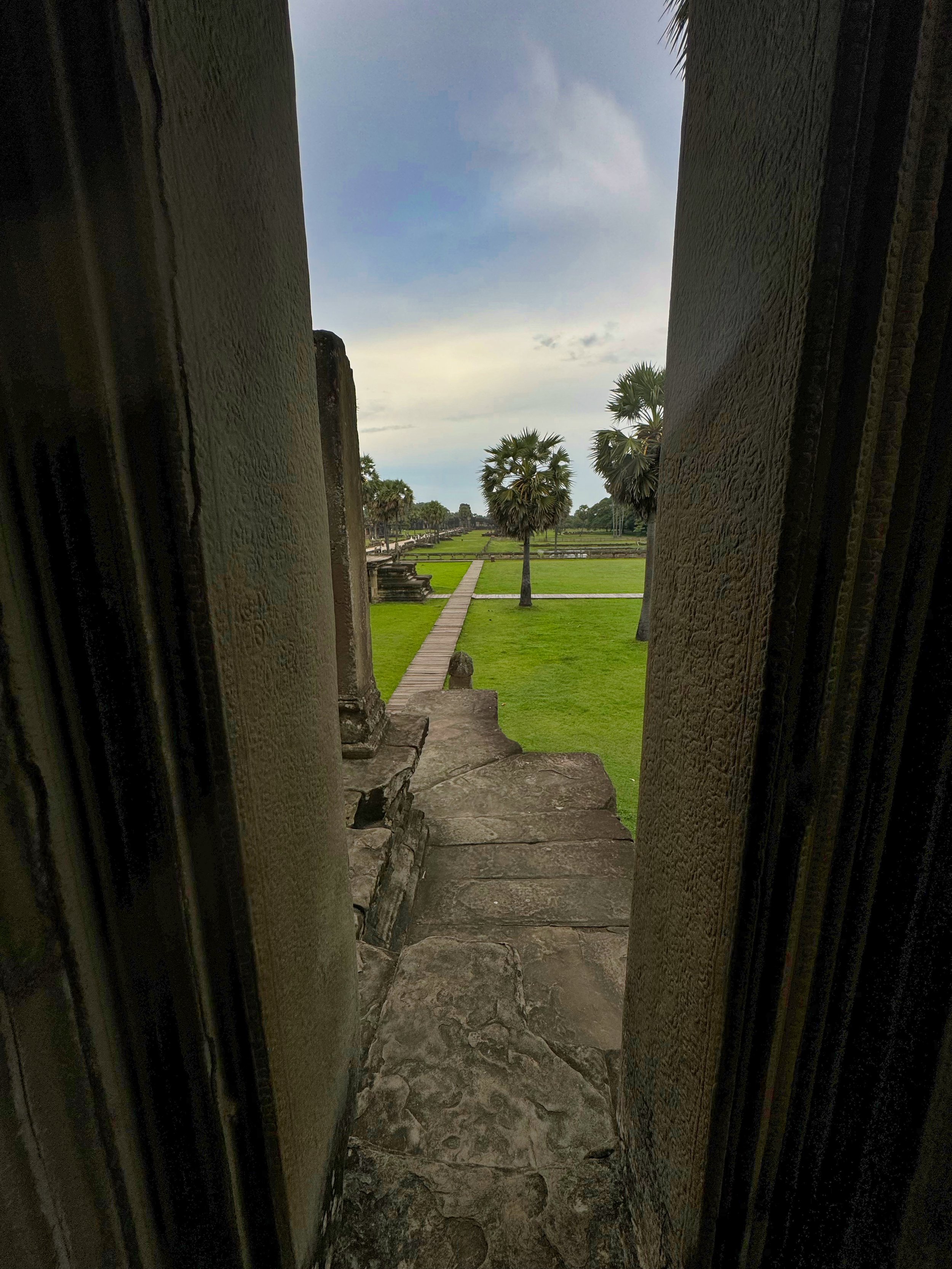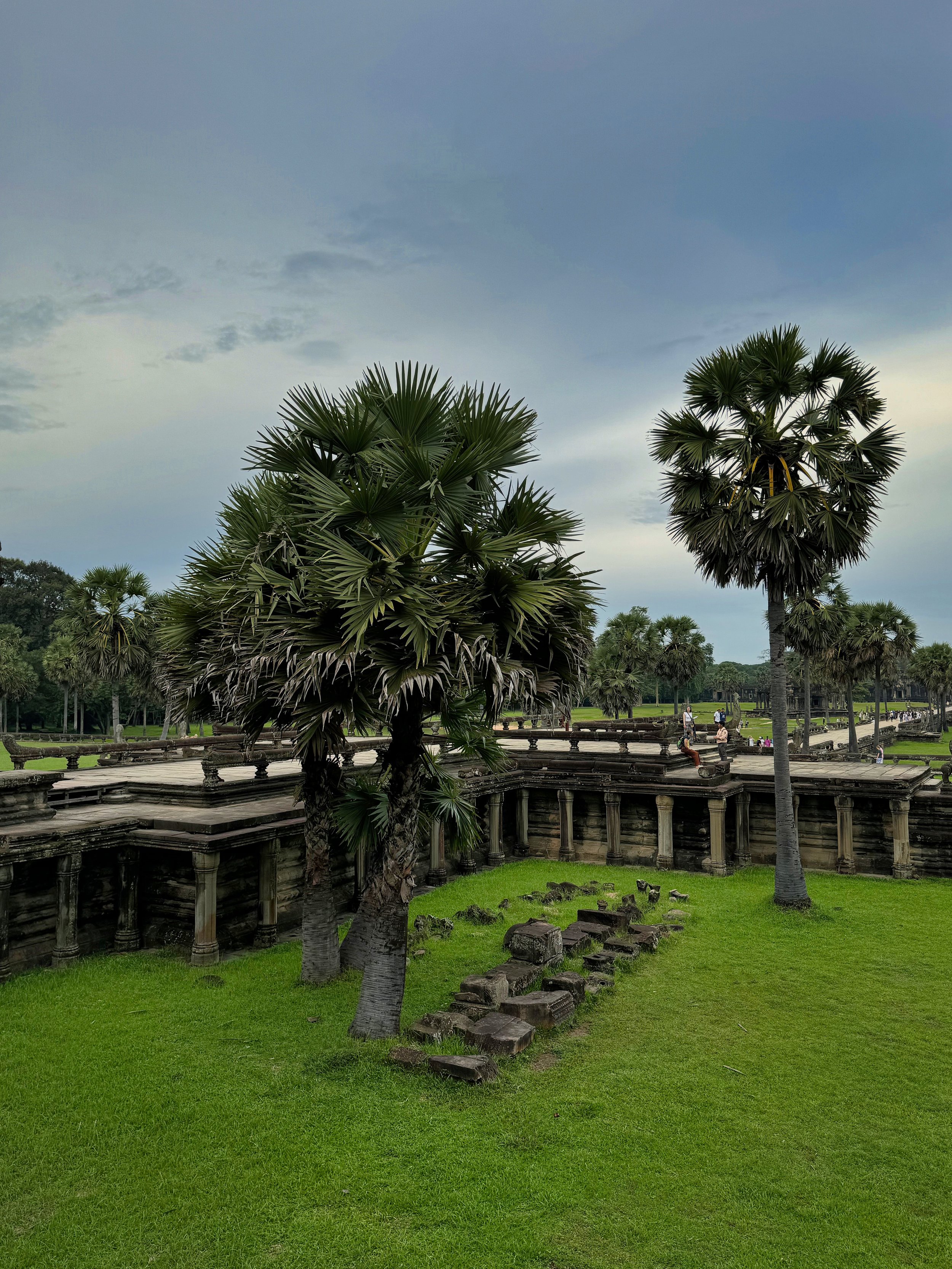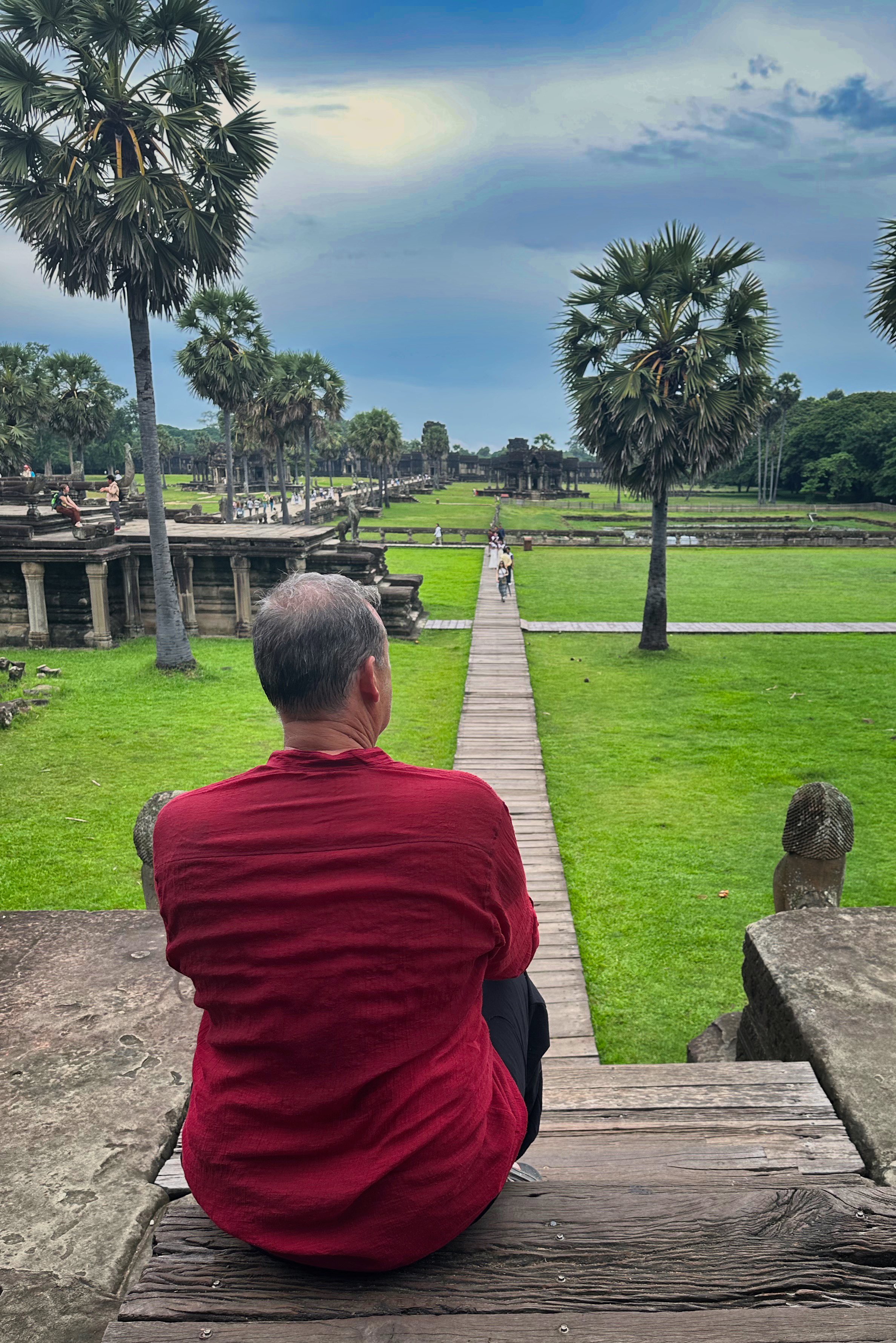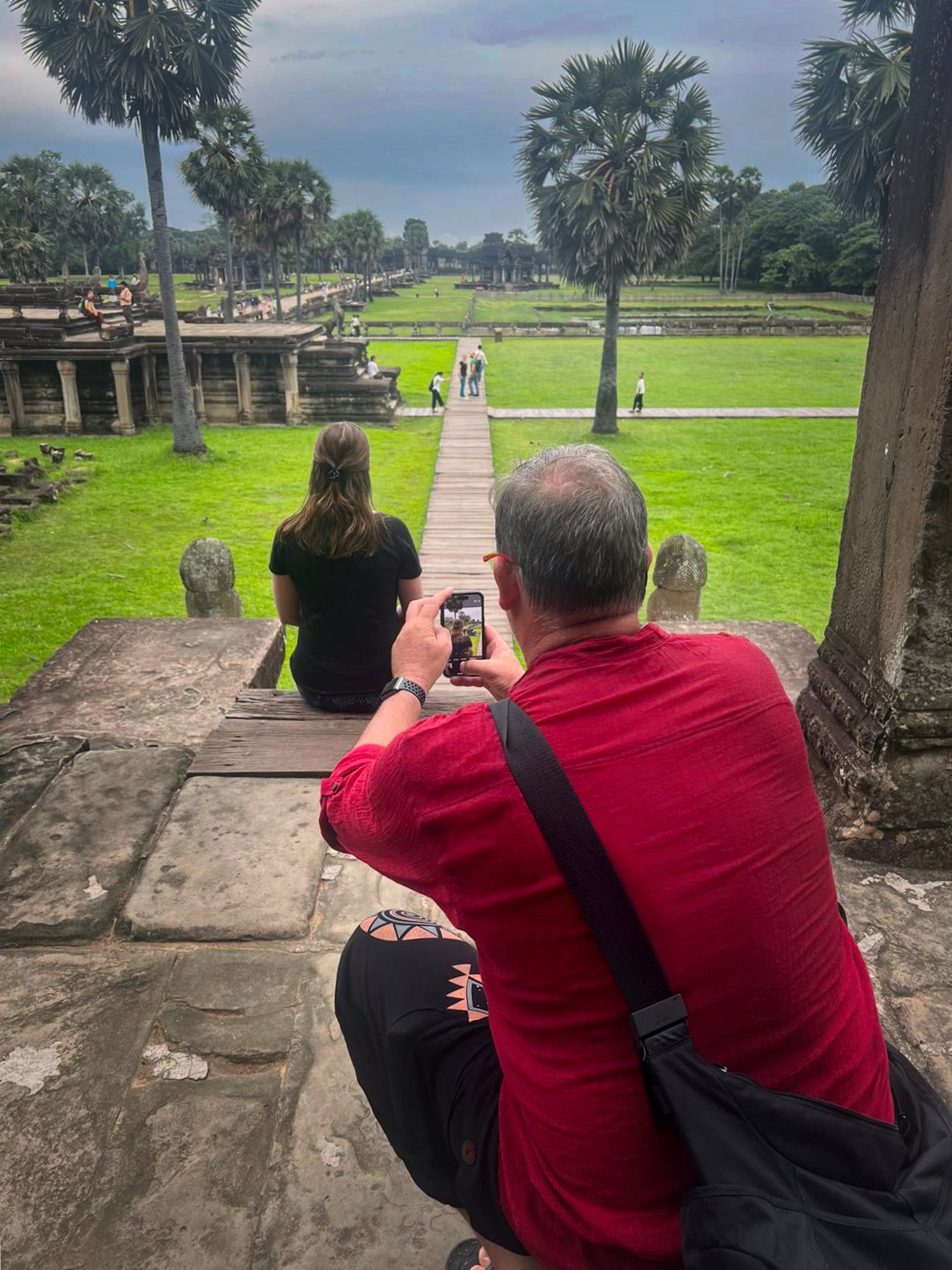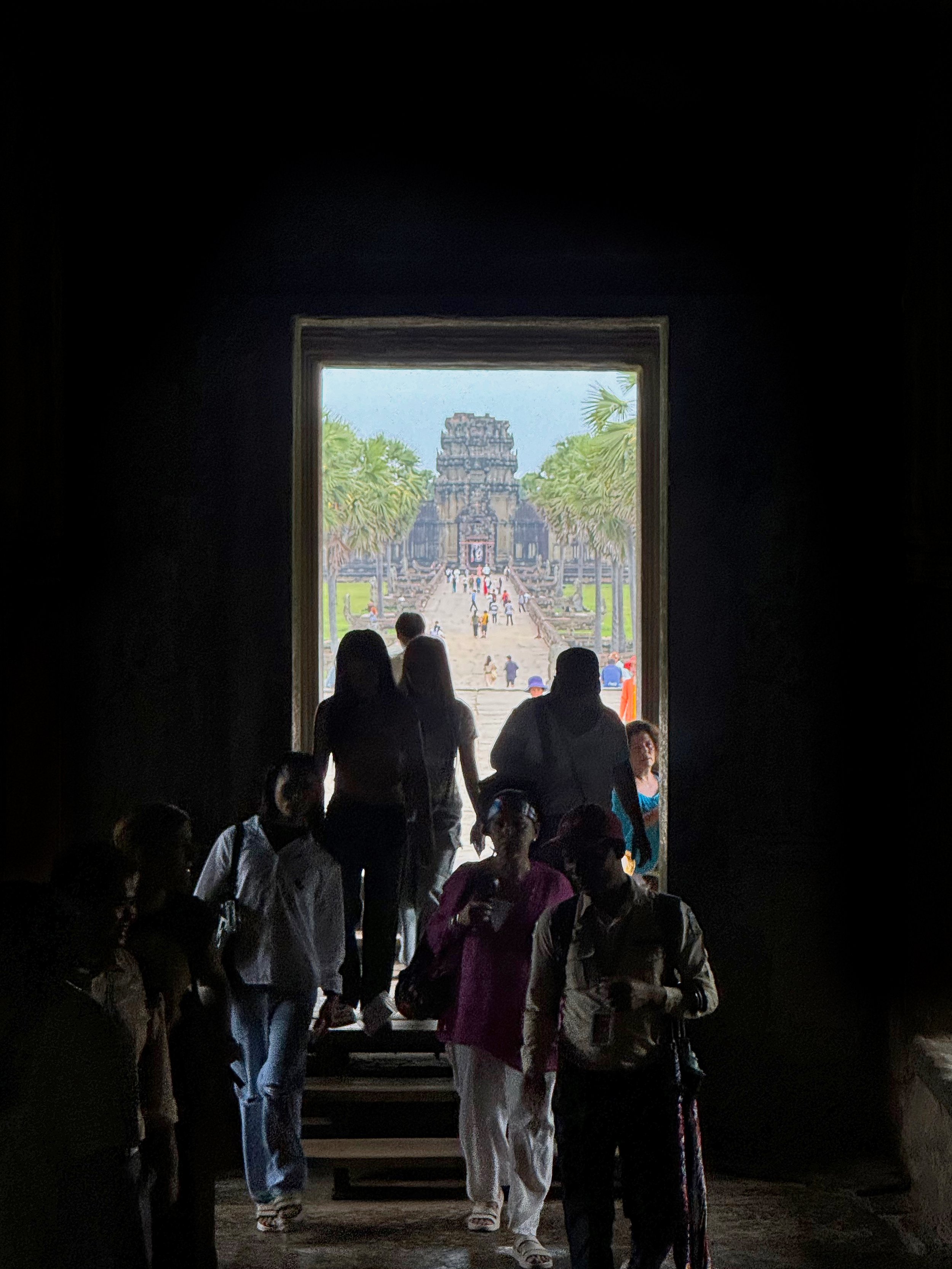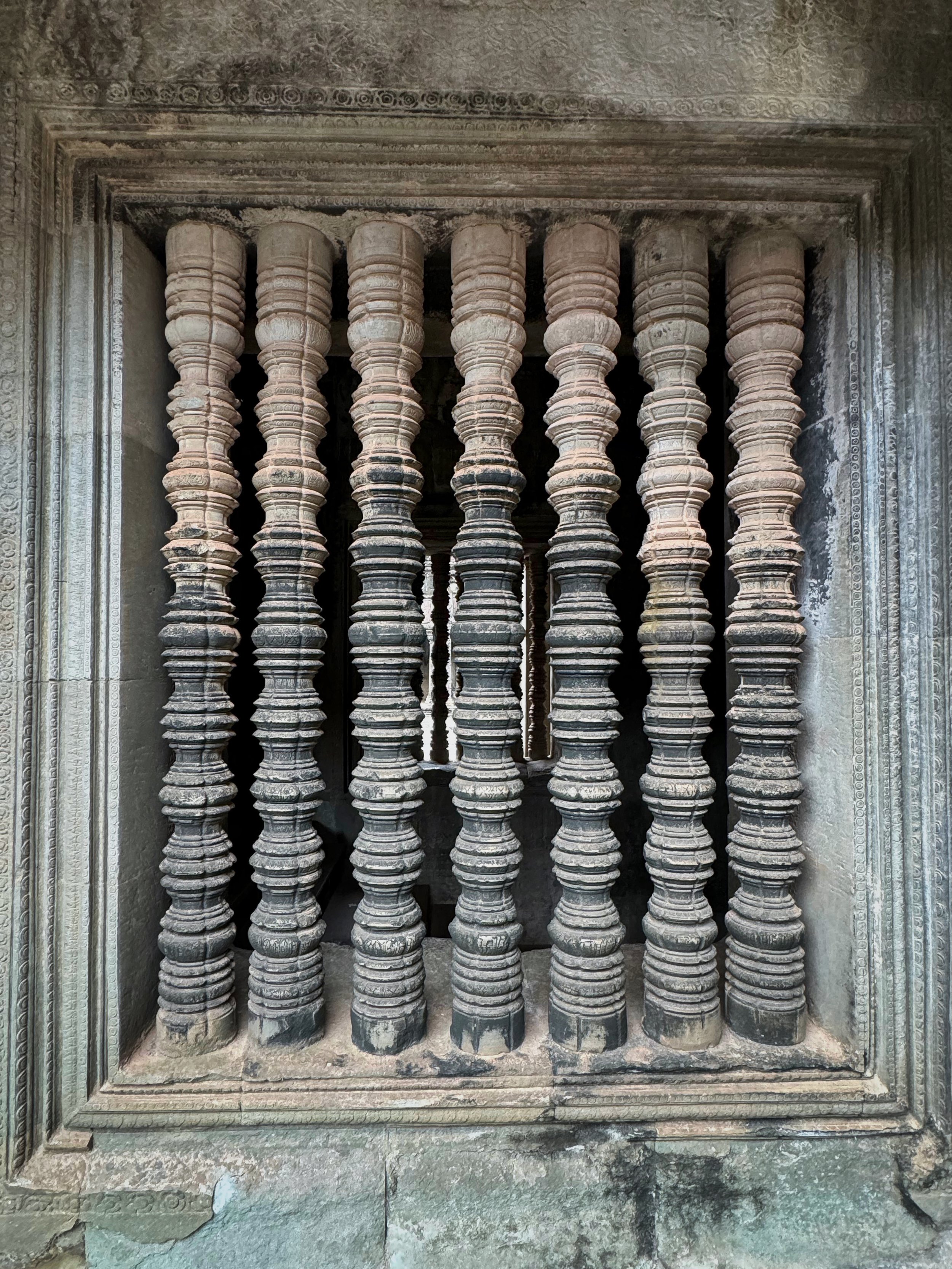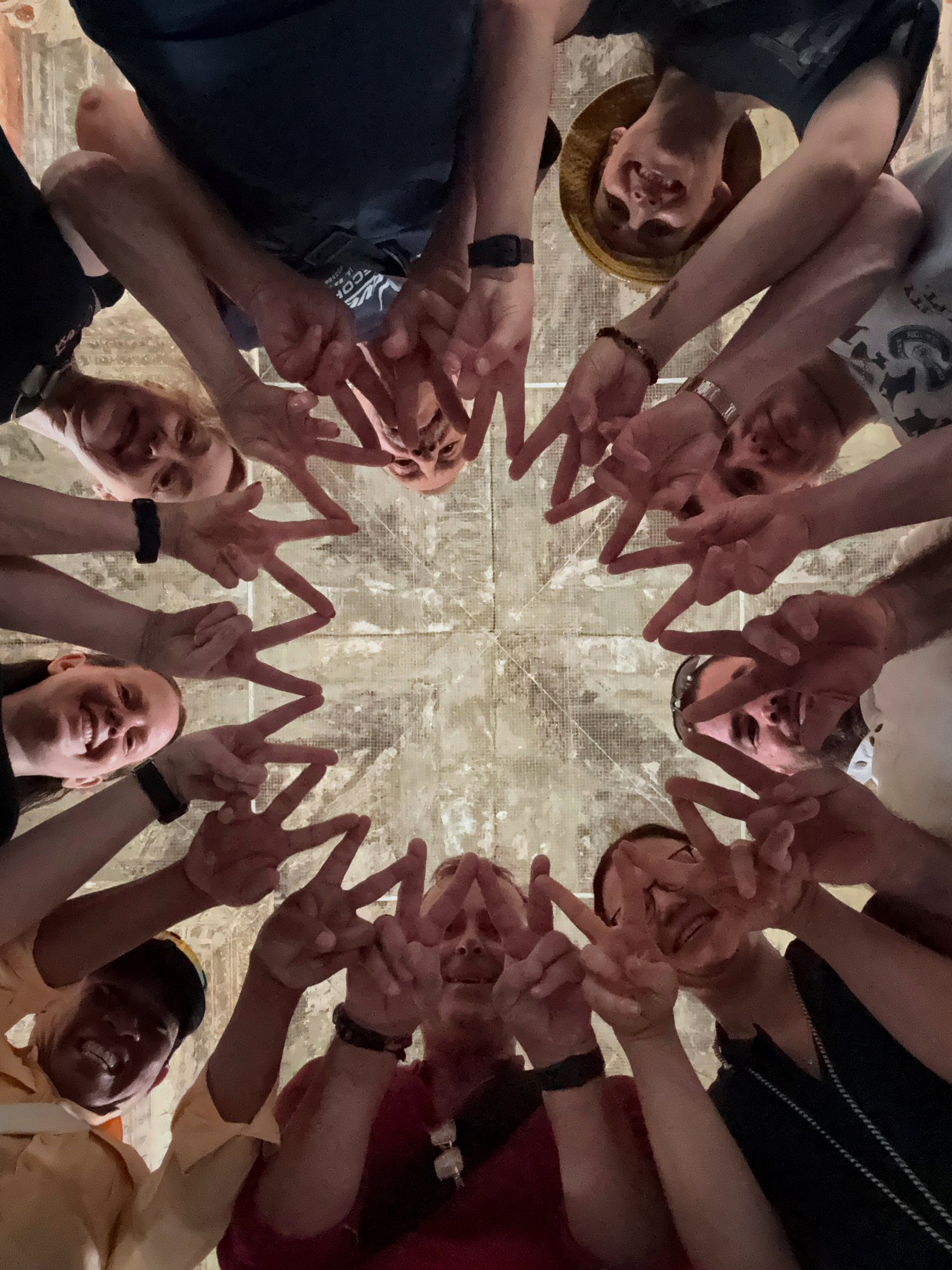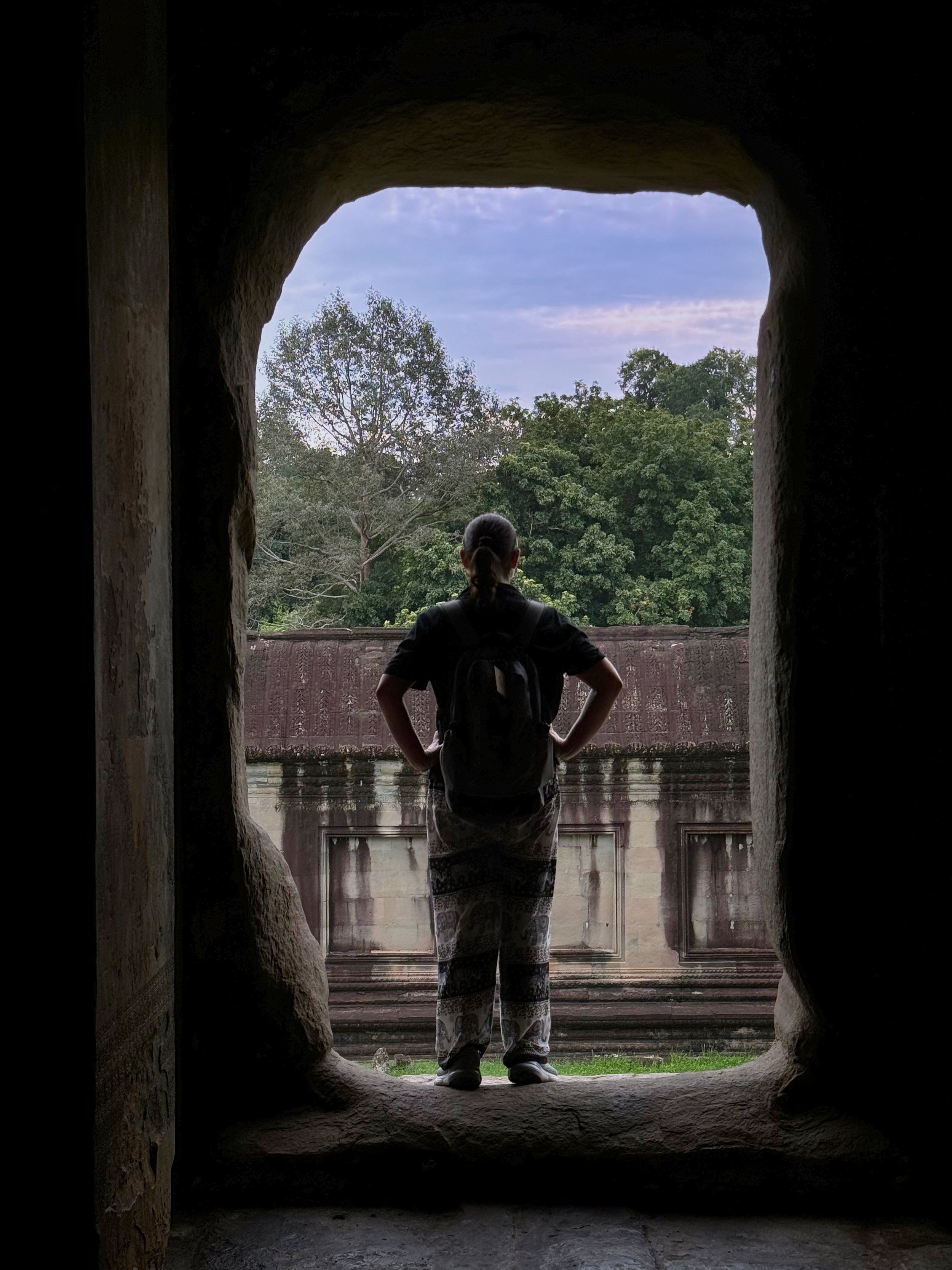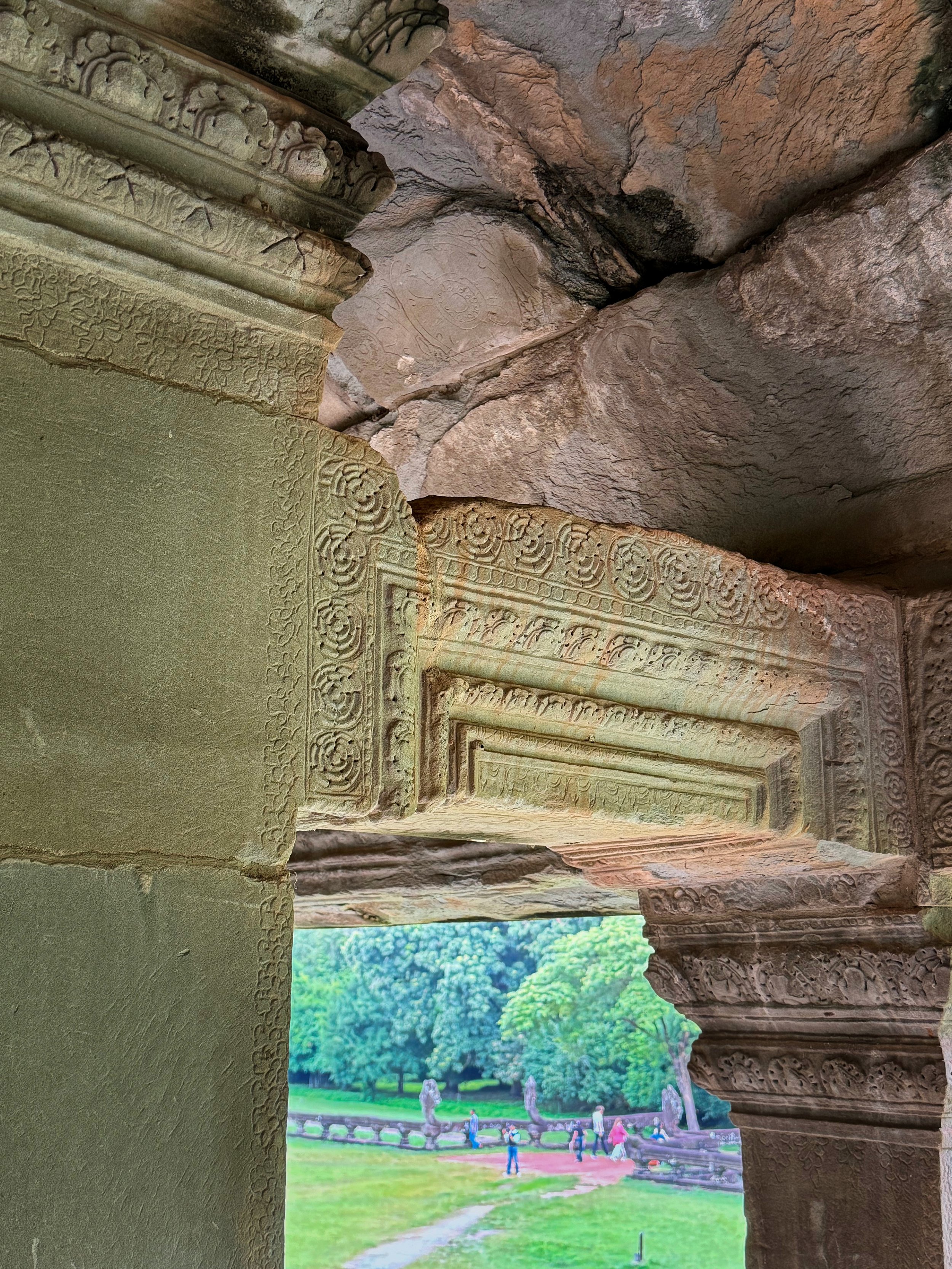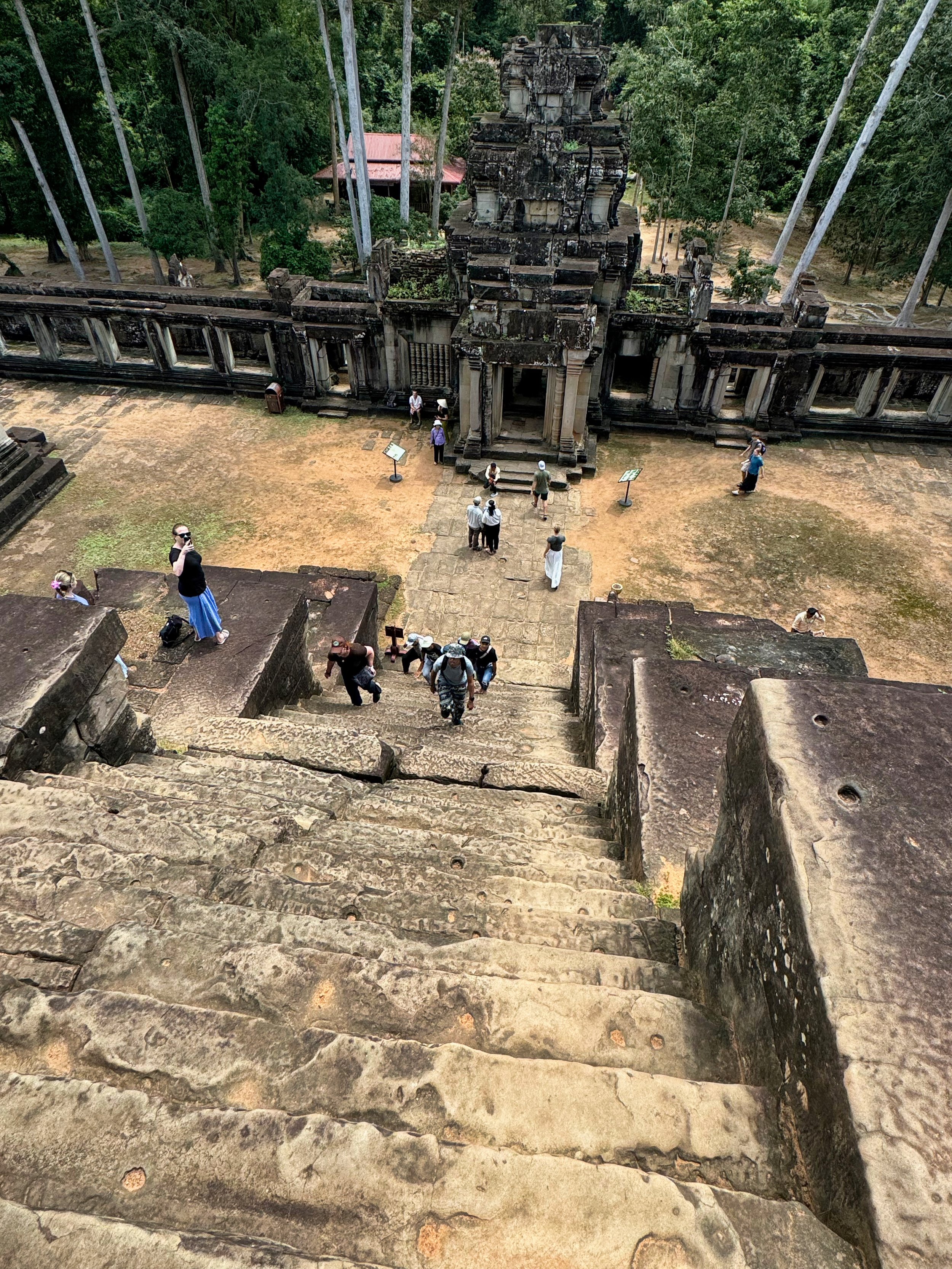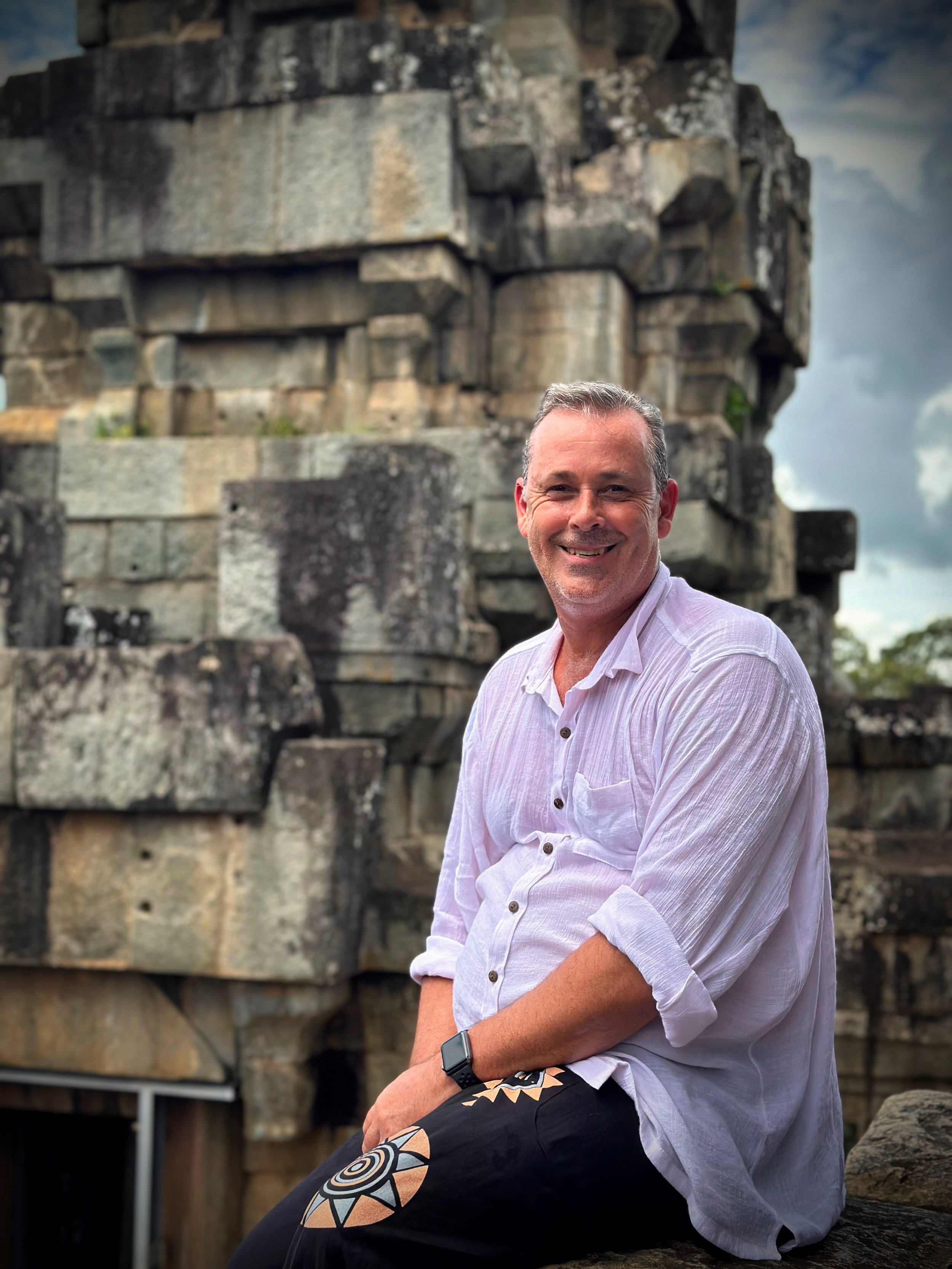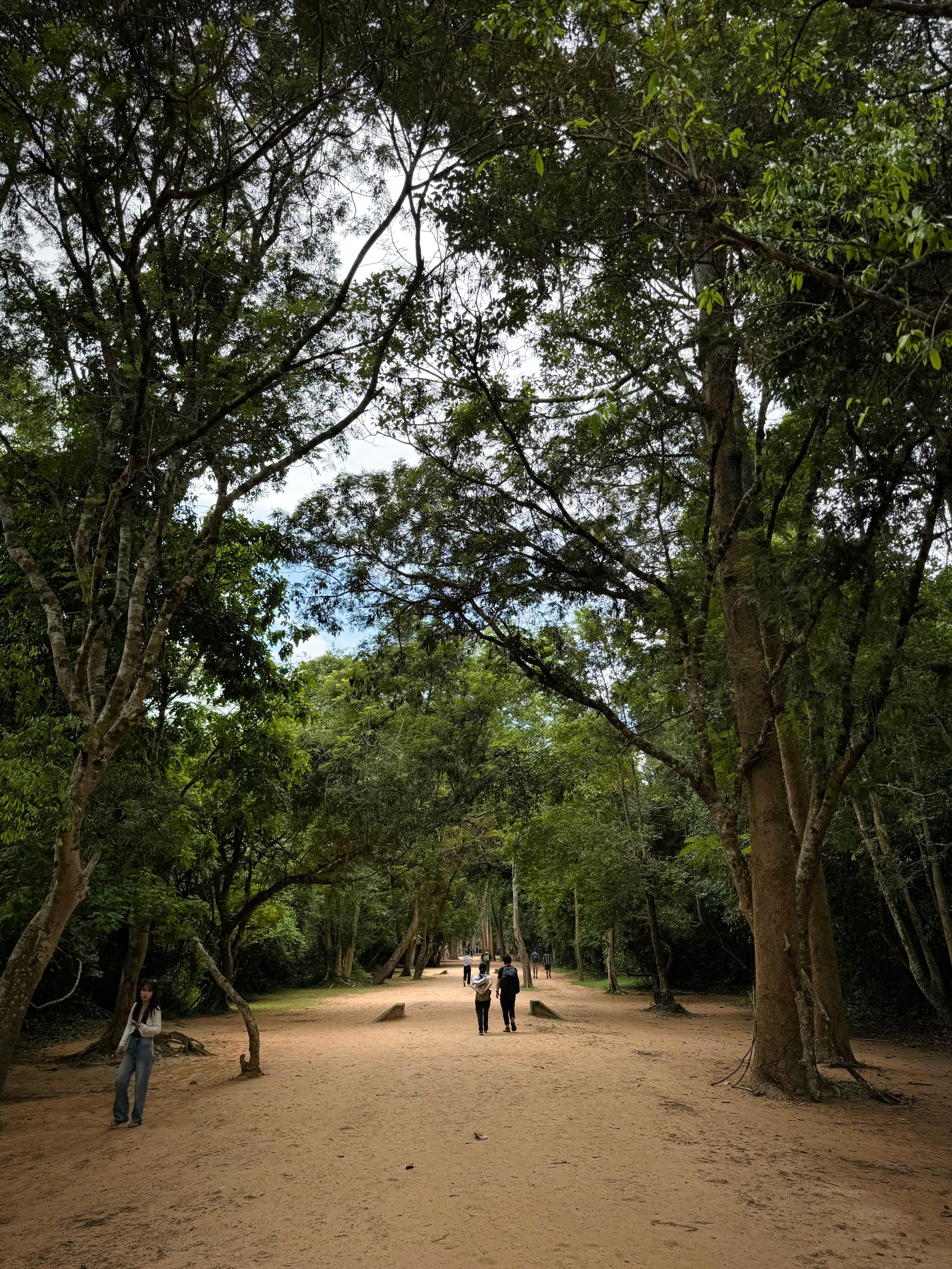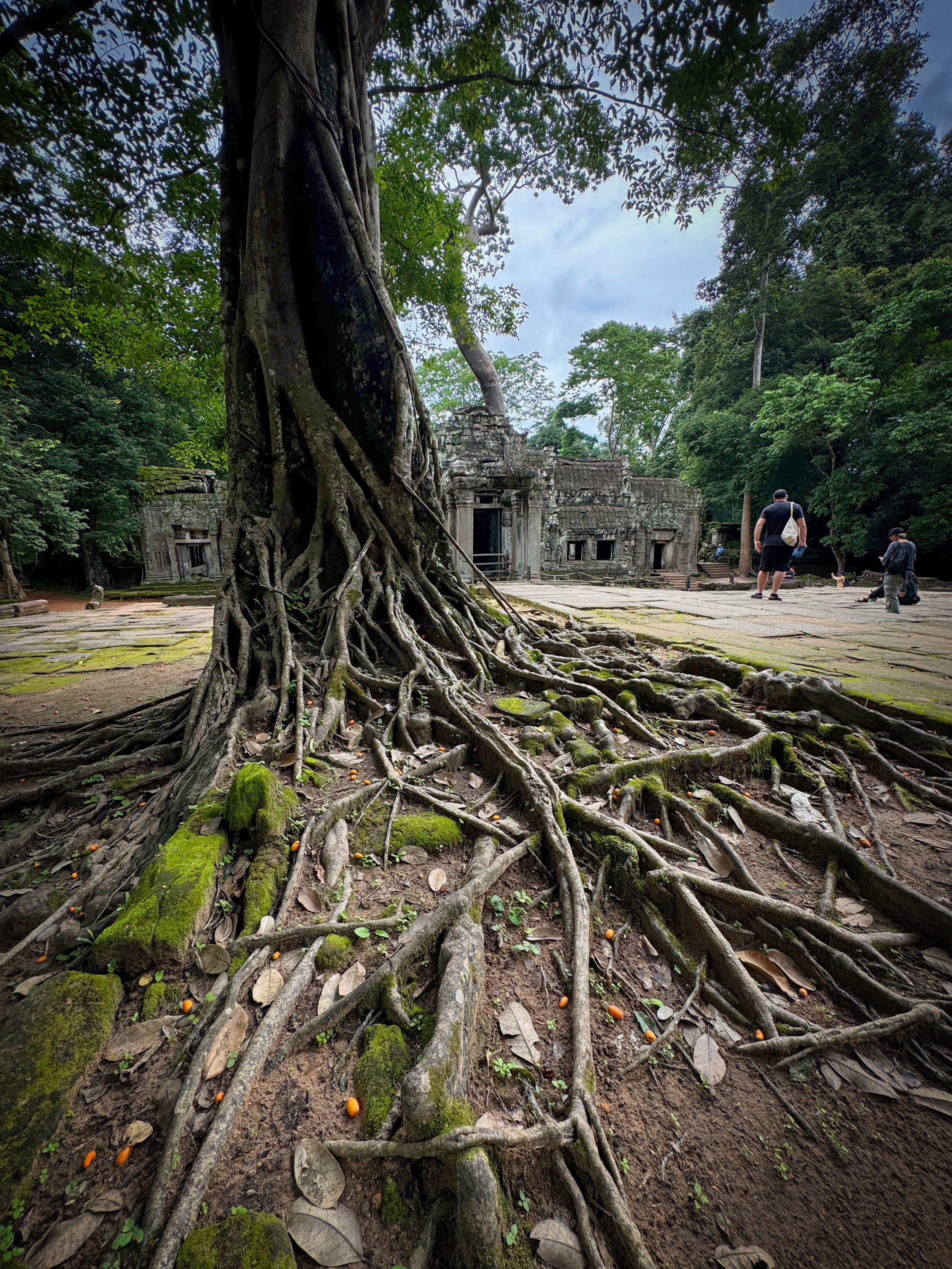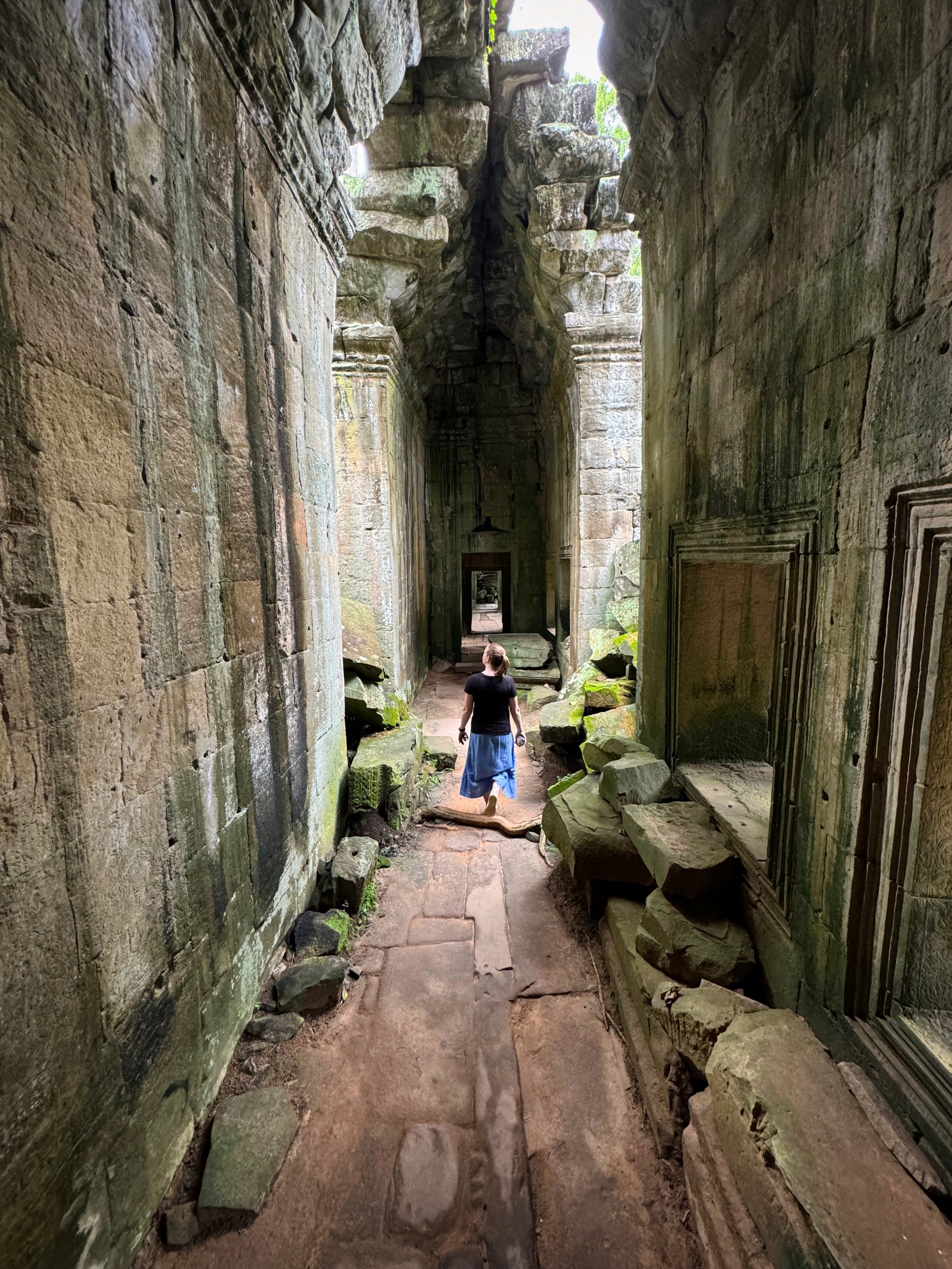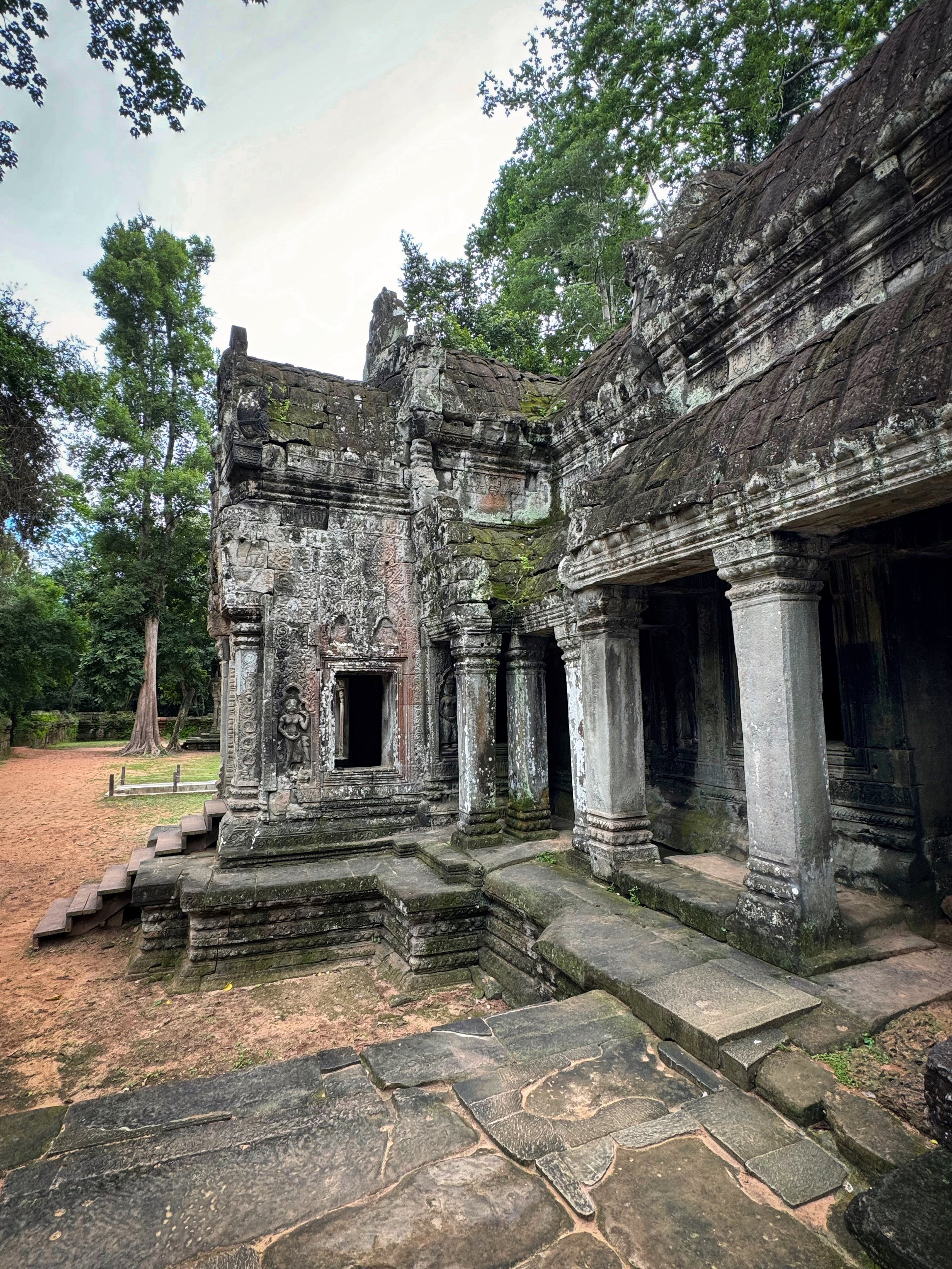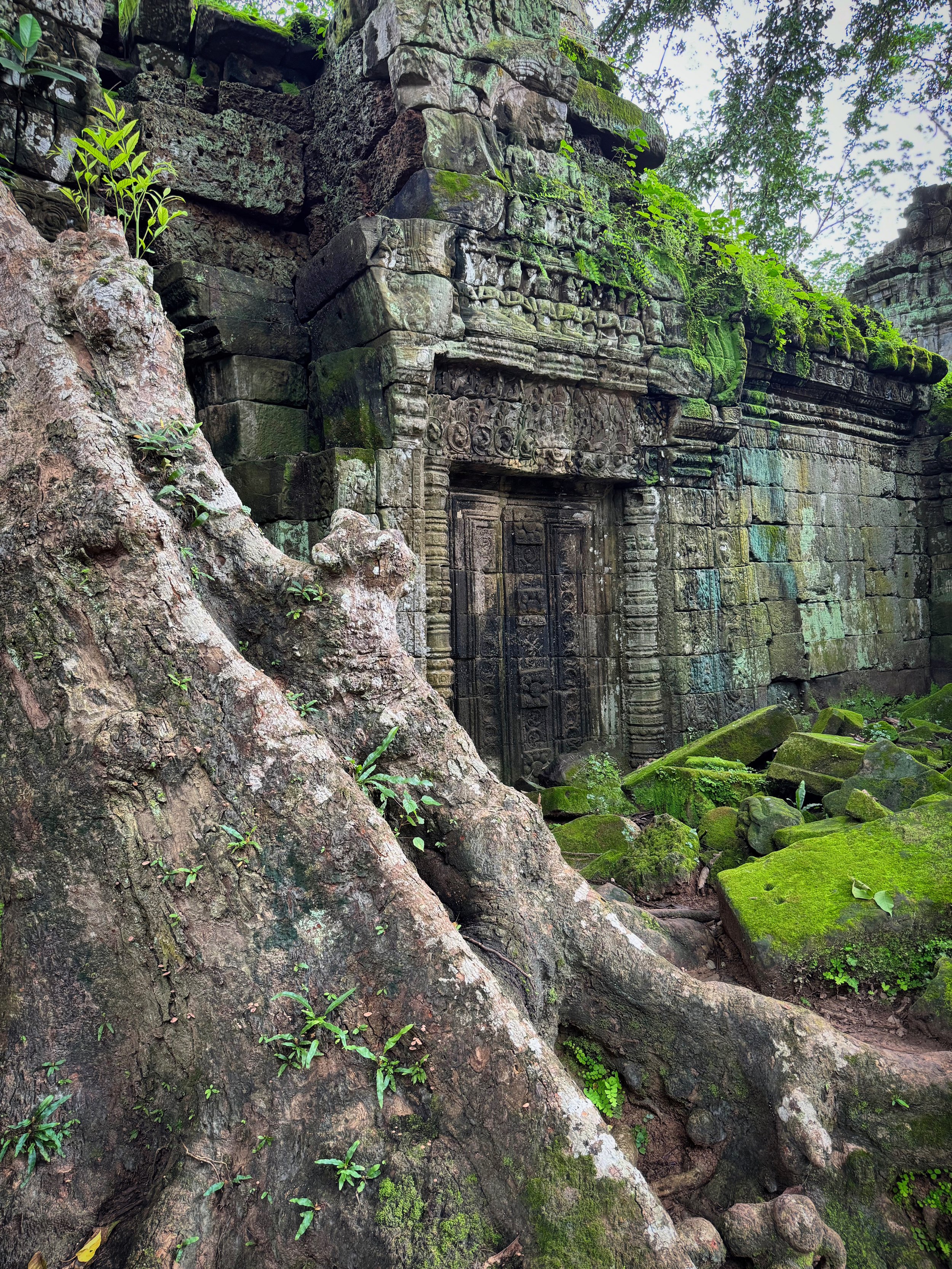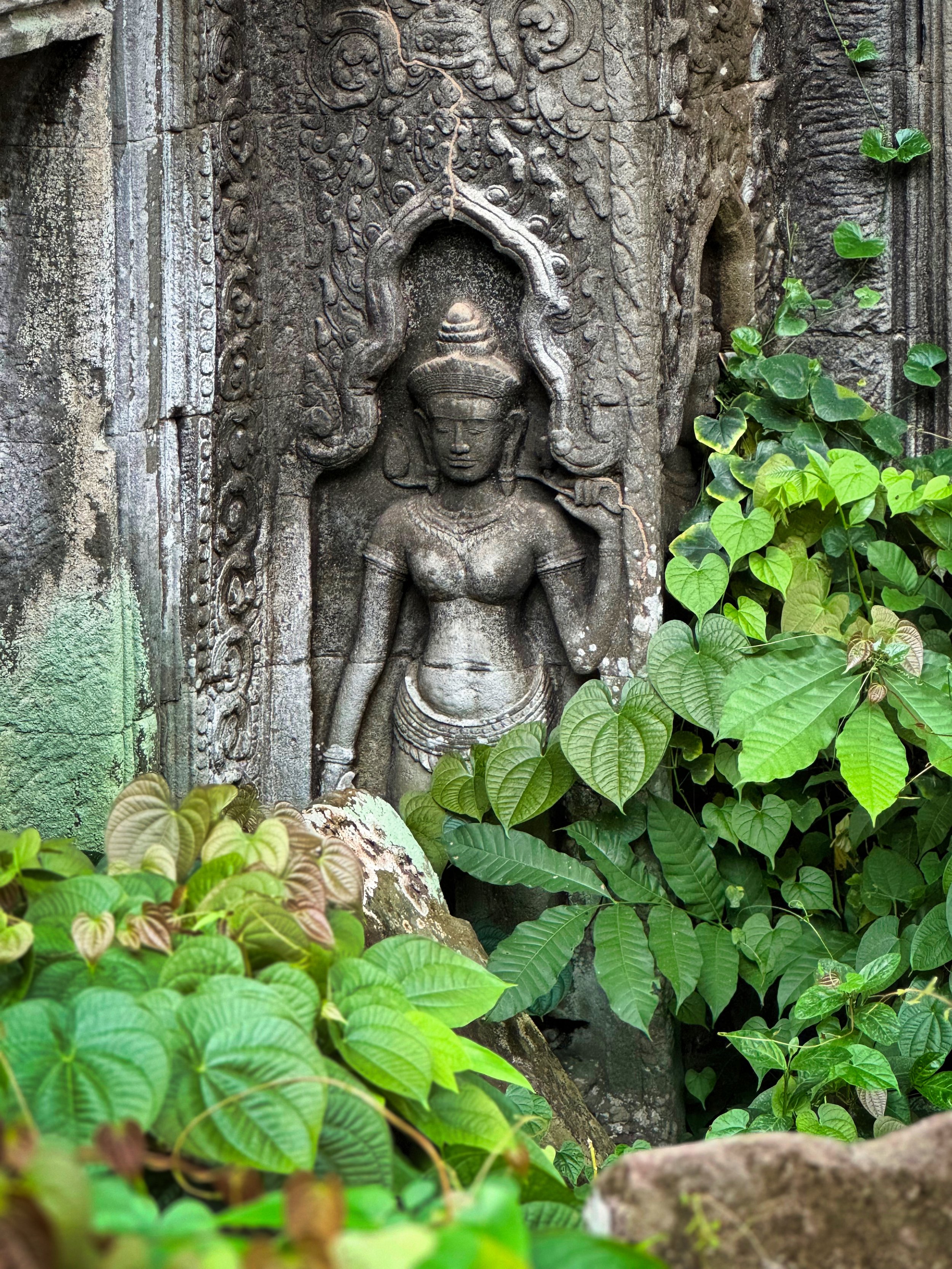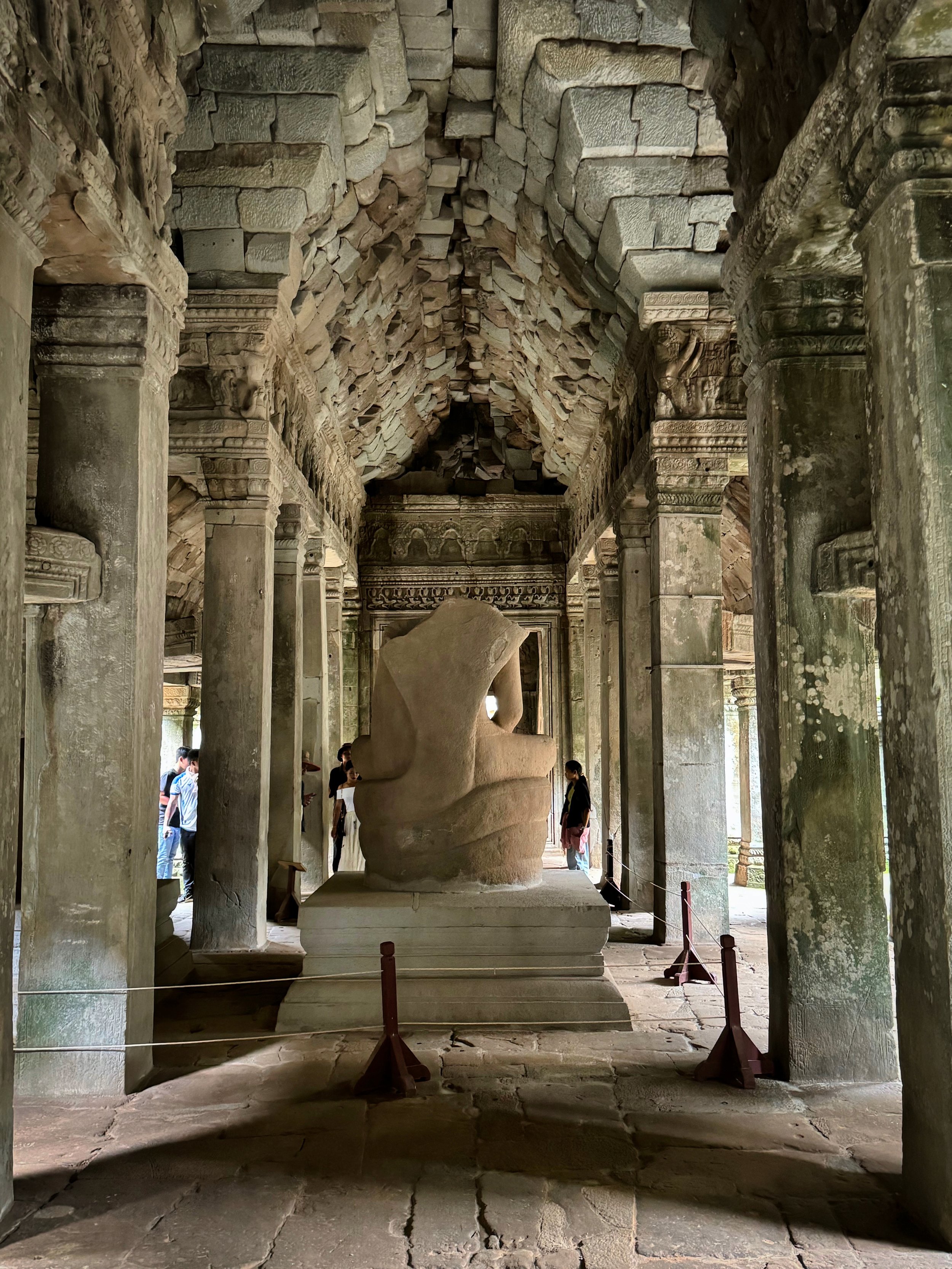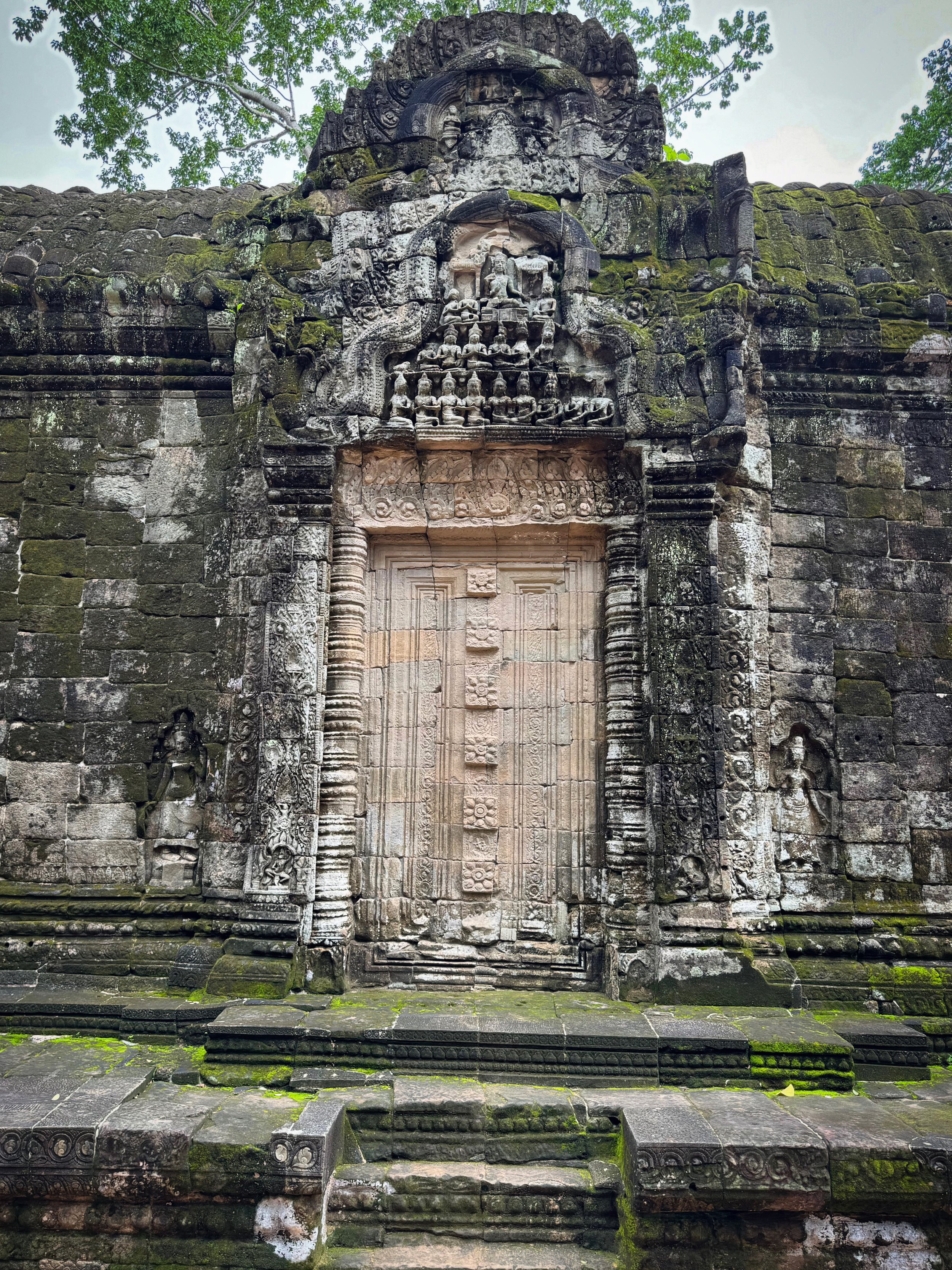Day 5 - Angkor Wat
Rising well before the sun, today was another of those highly anticipated, blue ribbon itinerized days with everyone remarkably on time for roll call - even Rachel. Meeting in the hotel foyer we startled the sleeping Sonolong employees who apparently stay on site in makeshift beds behind the counter, within the office or even on the benches surrounding the main entrance. Blurry eyed we were heading out to Angkor Wat for a day of religious enlightenment and ancient stone work amazement. Be warned good reader, photography is the basis of this entire website and today quickly became a photographers delight so there may be more photos than perhaps necessary.
Angkor Wat, Siem Reap, Cambodia
Angkor Wat is a Hindu-Buddhist temple complex encompassing a massive 402 acre site and considered the largest religious structure in the world. Originally constructed in 1150 as a Hindu temple dedicated to the deity Vishnu, it was gradually transformed into a Buddhist temple towards the end of the century over a 30 year period. Built at the behest of the Khmer king Suryavarman II as his state temple and eventual mausoleum, Angkor Wat combines the basic plans of Khmer temple architecture and is surrounded by a moat more than 5km in length. Enclosed within an outer wall 3.6km long, three rectangular galleries each rise above the next with a quincunx of towers standing at their centre.
We were dropped off not far from the entrance but it was difficult to absorb the full majesty of this place in the dark. Reminiscent of the Taj Mahal, we were among hundreds of people doing the same thing and steps grew quicker the closer we got to the prime vantage points which were two rectangular reflecting pools at the western entrance producing most quintessential shots of Angkor Wat. Today though one was closed leaving the remainder more tightly packed than normal. Fatpap barged his way to the front and set up his tripod as a makeshift barrier but with increasing light thick clouds filled the skies taking any sunrise banger quickly off the table. That’s not to say the sight wasn’t amazing, because it was, and we sat for nearly an hour marvelling at the structure and ripping out photo after photo.
Fitted out with our new temple appropriate Cambodian threads, we spent some time on the ornate sandstone causeway transiting the outer moat before moving toward the northern end of the complex under Toneth’s guidance. Visitors must be accompanied by registered Angkor guides throughout the complex and today ours was wearing his appropriate uniform with pride.
The temple complex fell into disuse before being restored in the 20th century by various international agencies and has been admired for its grandeur and harmony of architecture together with its extensive bas-reliefs and devatas adorning its walls. Designated a UNESCO World Heritage Site in 1992, it is regarded as one of the best examples of Khmer architecture and a symbol of Cambodia proudly incorporated into its national flag. We walked across the outer apron to enter the temple itself via one of the three main entrances and this was where the draw dropping moments came thick and fast. The outer wall is almost 4 km long and 5 mtrs high made of sandstone blocks quarried 40km away with almost every conceivable surface decorated with intricate reliefs illustrating scenes from Indian literature.
Stunned, we sat for a moment reflecting on the absolute beauty of the place before entering one of its many long, symmetrical passageways. Running the perimeter of the temple along the 3 distinct walls, they tempt ones eye to find any imperfections in alignment - there are none - and randomly open onto either more passageways or rooms equally as beautiful. The first western visitor to Angkor Wat was a Portuguese friar in 1586 who said it was "of such extraordinary construction that it is not possible to describe it with a pen, particularly since it is like no other building in the world. It has towers and decoration and all the refinements which the human genius can conceive.”
Through one of those many passageways we emerged into the first tier gallery with four large towers at the ordinal corners surrounding a higher fifth tower in the middle. The pattern is called a quincunx and believed to represent the mountains of Meru, the sacred five-peaked mountain of Hindu considered to be the centre of all the physical, metaphysical, and spiritual universes. It is within these inner walls the visitor truly becomes engulfed in Angkor Wat’s intricacies with detail and precision on literally every piece of stone.
In 1993 Angkor saw only 7,650 visitors but just before covid over 2.6 million tourists walked its halls. That influx caused damage such as graffiti, so ropes and wooden steps were introduced to protect the bas-reliefs and floors. Tourism though has provided additional funds for maintenance and around 28% of ticket revenue is now spent on the temples.
From the gallery we found yet another gate leading back out to the second tier courtyard of manicured grass and very distinct palm trees between the outer and inner walls. Angkor’s beauty comes from the contrast of natural and man made elements and their apposing colour pallets, but for this writer also from its symmetry. While Angkor Wat is a unique combination of the temple mountain, the standard design for the Khmer empire's state temples, and concentric galleries derived from religious beliefs of Hinduism, the construction also suggests a celestial influence among certain features. The temple's east–west orientation and lines of sight from the terraces show specific towers to be at the precise location of the solstice at sunrise while the main tower aligns with the morning sun of the spring equinox.
Through a maze of almost identical corridors, we made our way to the southern exit of the inner level admiring even more of the intricate artwork etched onto the floor and walls equally forming part of the architecture of the buildings. Restoration work beginning in the early 1900’s was interrupted by the Cambodian Civil War and abandoned entriely during the reign of the Khmer Rouge. Camping forces used whatever wood remained in the building structures for firewood and a shoot out against Vietnamese forces left bullet holes in the bas reliefs. Though in the late 1980s and early 1990s far more damage was done by art thieves working out of Thailand who lopped off many sculptures and other structures.
We ultimately left the complex via the western exit after 3 hrs exploring. In truth, you could spend much longer at Angkor Wat but we had other temples to visits.
Angkor Wat Eastern gate
Back on the bus the group returned to the hotel for a quick breakfast, and for Fatpap a much needed change of shirt, before heading out again for some more temple action. The Angkor Archaeological Park covers a huge 400 square kilometres and contains hundreds of monuments and structures once forming part of the great Khmer empire. Hidden among the jungle vegetation the most famous of these are Angkor Wat and what has become known as the “Tomb Raider” temple, but others punctuate the landscape and in their own way are as equally significant.
The first stop was to Ta Keo which is a temple-mountain thought to be the first built entirely of sandstone by the Khmer Empire. As the state temple of Jayavarman V, it has five sanctuary towers arranged in a quincunx built on the uppermost level of a five tier pyramid surrounded by moats as a symbolic depiction of Mount Meru. Its particularly massive appearance is due to the absence of external decorations as carvings hadn’t started when the work stopped abruptly.
Ta Keo Temple, Angkor, Cambodia
From the outset this temple was different. Primarily because of virtually no crowds, but it was the sheer scale of height making the structure so impressive. Walking along a soil causeway the sun was now out, the sky an evocative blue with the earthen tones of dirt, trees and the temple itself creating a vivid colour pallet perhaps not seen whist in Cambodia. The temple axis runs east to west with a 122 by 106 mtr sandstone wall perimeter holding two long galleries with wooden and tiled roofs once illuminated by balustrade windows along the eastern side. The second terrace is 5.5 mtr higher and where the colossal nature of this magnificent temple becomes evident.
After strolling the lower courtyard a commitment was necessary so we started the long climb up the central staircase. Under the guise of a photo stop, we paused briefly at certain points for breath but to also admire the magnificance of Ta Keo. The steps themselves were massive, significantly deeper and higher than used to, and were relentless in their path to the next level..
Jayavarman V was only ten years old when he succeeded his father in 968 and his early years of reign were dominated by court officials and royal politics. So at 17 he began construction of his own state temple, Ta Keo, originally called Hemagiri, "the mountain with golden summits". However the temple was never fully completed under his reign and according to some inscriptions work stopped abruptly due to a lightning strike hitting the unfinished building with most seeing that as an evil omen.
Reaching the next level, looking back down gave an even greater appreciation of this place with its block-like construction even more prominent the further we rose. With clear distinction of the 5 towers of the temple mountain design, there were piles of unplaced stones and of course lack of ornate facades rounding out the edges as seen at Ankgor Wat and other monuments. Climbing the central tower we reached its 45 meter summit to be rewarded with a 360 degree view of the jungle beyond. Hidden within the depths of the central tower was a shrine perpetually served making various offering to the gods. Naturally as enduring heathens we took photographs.
Ta Keo Temple summit
Mel and Fatpap had at this stage lost the group entirely along with any other life forms to find themselves admiring the view alone from the very edges of the main tower. Here a lone security guard kindly offered to take some photos for us, which was extremely charitable, but of course the grift soon followed with tales of his sick daughter, his sons expensive education, and the poor pay received by the Angkor Archaeological Park. Fatpap reluctantly parted with an Abraham Lincoln sitting idly in his pocket and the pair hastily descended before forking out any more. In that haste we truly became lost circling the middle level trying to find the correct exit only to emerge at the wrong one to find Toneth’s beaming smile waiting for us nonetheless.
A little over a kilometre away our next temple of prominence was the famed Ta Prohm, more colloquially known as Tomb Raider Temple. Exposed to westerners by Angelina Jolie in the movie Tomb Raider, Ta Prohm was built in the Bayon style largely in the late 12th and early 13th centuries by the Khmer King Jayavarman VII as a Mahayana Buddhist monastery and centre of learning. Constructed without mortar, after it was abandoned trees and the jungle surroundings took root in the loosened stones making it now one of the most popular temples in the park and earning a UNESCO World Heritage Listing in 1992.
The walk into the temple was via a long dirt road canopied by trees offering some respite from the Cambodian heat. Surprisingly the tourist numbers were nowhere near as expected and right from the entry courtyard we knew this temple would be something completely different again. It was smaller for one, swallowed by the jungle and being flat full of surprises at every turn as no great scope could be achieved from any vantage point.
In 1186 Jayavarman VII embarked on a massive program of construction with Ta Prohm being one of the first temples pursuant to the works. The temple's stele records that the site was home to more than 12,500 people, 18 high priests and 615 dancers, with an additional 80,000 inhabitants in the surrounding villages working to provide services and supplies. The temple also amassed considerable riches, including gold, pearls, and silks.
Ta Prohm Temple, Angkor Archaeological Park, Cambodia
The trees growing from the ruins are perhaps the most distinctive feature of Ta Prohm prompting more attention than the stonework itself. The largest of these, and most recognisable are the octopus-like roots of a tree growing over a building right at the entrance to the inner moat of the site. The design of Ta Prohm is that of a typical '“flat" Khmer temple as opposed to a pyramid or temple-mountain, with five rectangular enclosing walls surrounding a central sanctuary centred around the stone face of Prajnaparamita, the personification of wisdom, modelled after the King's mother.
After the fall of the Khmer Empire in the 15th century the temple of Ta Prohm was abandoned and neglected for centuries. When French explorers first discovered the overgrown buildings at the ancient capital of Angkor in the late 1800s, much of the area was completely covered by forest. In particular, the roots of strangler figs, kapok, and banyan trees aggressively engulfed the structures. When conservation efforts began in the 1900’s the site was deliberately left as it had best “merged” with the jungle and they wanted to create a sharp contrast with the painstaking reconstruction of other temples in the complex. At present, the temple is only conserved to prevent further building collapses and to clear passage for visitors with roped railings and wooden boardwalks.
Ta Prohm is a stunningly beautiful temple and uniquely interesting compared to its counterparts within the park. The collapsed stonework, invasion of trees and multitude of green mosses thriving in the shelter offered by the surrounding jungle add to the authenticity of Ta Prohm presenting the temple to us modern humans in a form we perhaps expect by stereotype. Of the three temples explored today within a relatively small footprint, it was interesting to note the significant differences between them all given they ostensibly serve the same purpose. Mans beliefs are idiosyncratic and interpretations can obviously change over the course of centuries.
We lunched in a small restaurant within the park grounds then returned to Siem Reap and our hotel for a swim, drink and relax after such a monstrous day. A few of us headed into town in the evening for a Mexican dinner of all things where Fatpap over indulged himself as usual but otherwise all others maintained some semblance of decorum. It was an early night tonight given we’d been going since 3:30am with most quietly adjourning to their rooms or finding solace on their balconies swiping through the hundreds of magnificent photographs taken during an awe insuring day.



